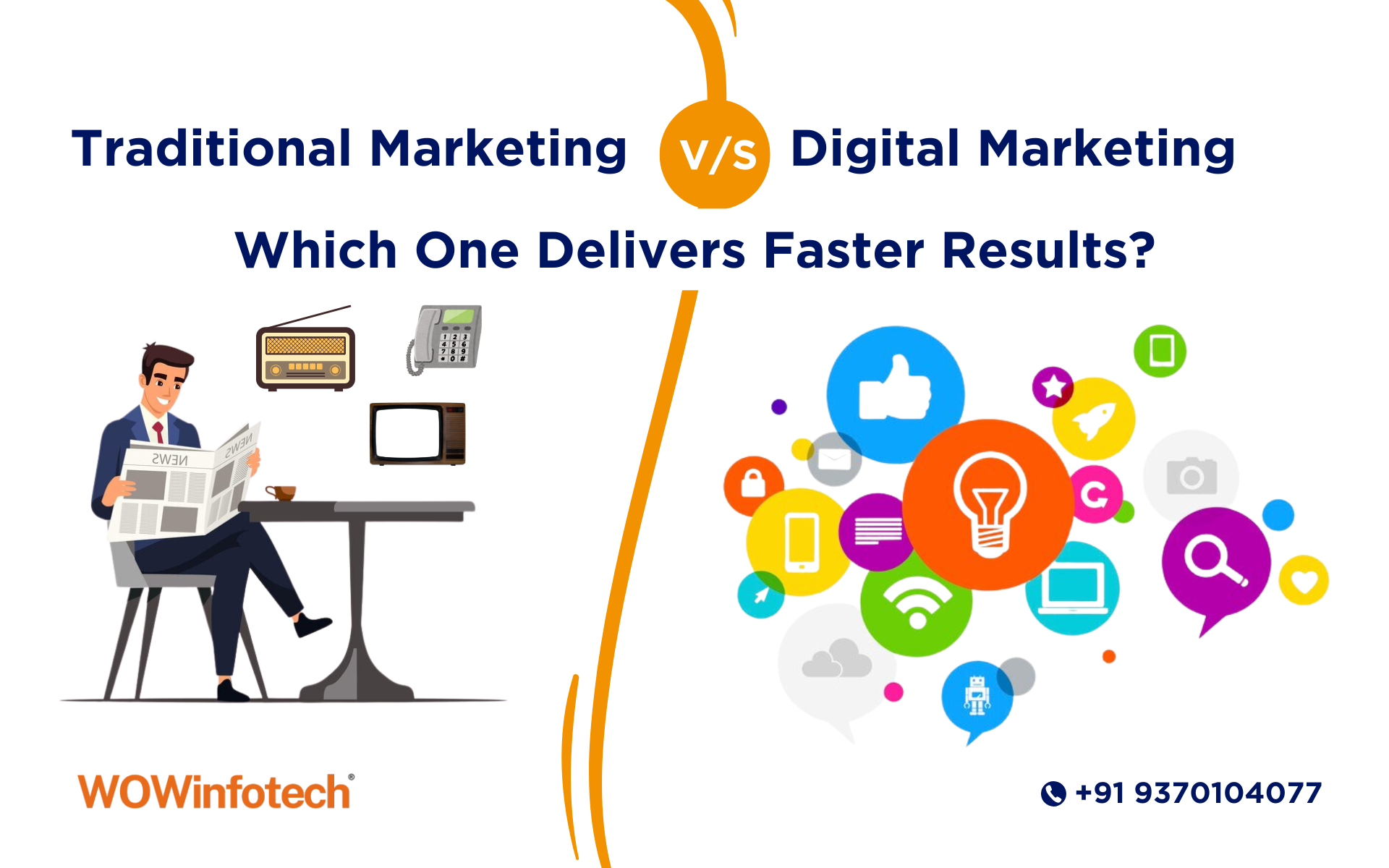Traditional Marketing vs Digital Marketing
Picture this: You're sipping coffee while scrolling through your phone and see an ad for those shoes you looked up yesterday. Later, you drive past a giant billboard for the same brand. Two different approaches the one is digital, and the other is traditional—both fighting for your attention.
Welcome to the "traditional marketing vs digital marketing" showdown!
In today's marketing arena, businesses have two heavyweight champions: Traditional Marketing and Digital Marketing.
But here's the real question: Which one deserves a spot in your marketing strategy?
Don't limit yourself on both types of marketing can help your business. Whether you're running a small local store or an online shop, using the right combination is what really works best.
What Is Traditional Marketing
Traditional marketing uses offline channels like TV, radio, newspapers, and billboards to reach a broad audience. It’s effective for local promotions and brand recognition but often comes with higher costs and limited targeting.
Print ads (newspapers, magazines)
Broadcast ads (TV, radio)
Direct mail (flyers, brochures)
Outdoor advertising (billboards, banners)
Despite the growth of digital marketing, traditional methods remain effective for reaching broad audiences, especially in local markets.
Key Features of Traditional Marketing
Tangible Media – Physical materials like newspapers and flyers leave a lasting impression.
Wide Reach – TV and radio ads target a large, diverse audience.
One-Way Communication – Brands deliver messages without immediate customer feedback.
Strong Brand Awareness – Repeated exposure builds familiarity and trust.
Local Focus – Ideal for small businesses targeting nearby customers.
High Costs – Producing TV commercials or print ads can be expensive.
Longer Lead Times – Campaigns take more time to plan and execute.
Emotional Appeal – Storytelling in TV and radio ads creates strong emotional connections.
Regulated Content – Must follow strict advertising laws and guidelines.
What Is Digital Marketing?
Digital marketing promotes products through online platforms like social media, websites, and email. Moreover, it offers precise targeting, real-time results, and global reach, making it ideal for modern, cost-effective business growth.
Key Components of Digital Marketing
Search Engine Optimization (SEO) – Improves website visibility on search engines.
Content Marketing – Uses blogs, videos, and infographics to attract customers.
Social Media Marketing – Engages audiences on Facebook, Instagram, LinkedIn, etc.
Email Marketing – Sends personalized promotions and updates.
Pay-Per-Click (PPC) Ads – Runs targeted ads on Google and social media.
Key Features of Digital Marketing
Precise Targeting – Ads reach users based on demographics, interests, and behavior.
Cost-Effective – More affordable than traditional ads, with flexible budgets.
Measurable Results – Tools like Google Analytics track performance in real time.
Two-Way Interaction – Brands engage directly with customers via comments and messages.
Global Reach – Expands market presence beyond local boundaries.
Multiple Formats – Includes videos, podcasts, and interactive ads.
24/7 Availability – Customers can access content anytime.
SEO & Content-Driven – High-quality content boosts search rankings.
Customer Reviews – Online testimonials influence buying decisions
Traditional Marketing vs Digital Marketing: Key Differences
|
Criteria |
Traditional Marketing |
Digital Marketing |
|
Medium |
TV, radio, print, and billboards |
Social media, SEO, email, PPC ads |
|
Cost |
Expensive production & distribution |
Budget-friendly with flexible options |
|
Targeting |
Broad audience, limited segmentation |
Highly targeted based on user data |
|
Measurement |
Hard to track (surveys, estimates) |
Real-time analytics (Google Analytics) |
|
Speed & Flexibility |
Slow changes, long lead times |
Quick adjustments, instant updates |
|
Reach |
Local or regional |
Global or hyper-local |
|
Challenges |
High competition, low engagement |
Constant algorithm changes, platform overload |
Pros and Cons of Traditional Marketing
Pros:
High Credibility – Consumers often trust print and TV ads more than digital ads.
Tangible Impact – Physical ads (billboards, flyers) create a lasting impression.
Better for Local Reach – Ideal for businesses targeting nearby customers.
No Tech Barriers – Accessible to audiences with limited internet usage.
Cons:
Expensive – High costs for production, placement, and distribution.
Hard to Measure ROI – Difficult to track engagement and conversions.
Limited Interaction – No direct customer feedback or engagement.
Slow Adjustments – Changes require reprinting or rebroadcasting.
Pros and Cons of Digital Marketing
Pros:
Cost-Effective – Lower costs with higher ROI potential.
Precise Targeting – Ads reach specific demographics and interests.
Real-Time Analytics – Track performance instantly and optimize campaigns.
Interactive Engagement – Direct communication with customers via comments, chats, and emails.
Global Reach – Expand business beyond geographical limits.
Cons:
Requires Technical Knowledge – Needs expertise in SEO, ads, and analytics.
Short-Lived Content – Social media posts and ads have a limited lifespan.
Ad Fatigue – Consumers may ignore repetitive online ads.
Dependence on Algorithms – Changes in SEO or social media algorithms can affect visibility.
Which One Should You Choose?
Both traditional and digital marketing have unique strengths:
Traditional marketing works well for local businesses and older demographics.
Digital marketing excels in precise targeting, cost efficiency, and real-time results.
Many businesses combine both strategies for the best results. A billboard or TV ad can boost brand recognition, while social media and SEO drive online engagement.
Final Thoughts
The debate between traditional marketing vs digital marketing isn’t about which is better—it’s about which fits your business needs. Traditional methods offer credibility and broad reach, while digital marketing provides precision and measurable results.
For businesses aiming to thrive in today’s competitive market, a balanced approach often works best. Therefore, if you’re ready to boost your online presence, WOWinfotech can help you craft a winning digital marketing strategy.
-

Krishna Handge
WOWinfotech
Dec 11,2024
